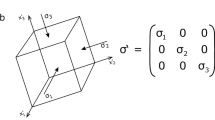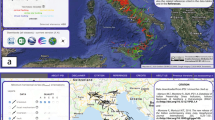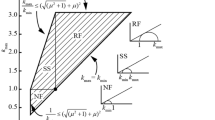Abstract
Knowledge of the in situ stress state is of key importance for rock engineering. We inform the reader about the World Stress Map (WSM) database and its application to rock mechanics and rock engineering purpose, and in particular the orientation of maximum horizontal stress. We discuss the WSM and the quality ranking system of stress orientation data. We show one example of discrete-measured and computed-smoothed stress orientations from central and northern Europe with respect to relative plate velocity trajectories. We give first insights into ongoing development of a second, more Quantitative World Stress Map database which compiles globally rock-type specific stress magnitudes versus depth. We discuss the vertical stress component, and the lateral stress coefficient versus depth for different rock types. We display stress magnitudes in 2D and 3D stress space, and investigate stress ratios in relation to depth, lithology and tectonic faulting regime.









Similar content being viewed by others
References
Aadnoy BS, Hansen AK (2005) Bounds on in situ stress magnitudes improve wellbore stability analyses. Soc Petroleum Eng SPE J 10(2):115–120
Addis MA, Hanssen TH, Yassir N, Willoughby DR, Enever J (1998) A comparison of leak-off test and extended leak-off test data for stress estimation. SOE/IRSM 47235. In: Proceedings of ISRM EUROCK98, vol 2, Trondheim, Norway, pp 131–140
Amadei BS, Stephansson O (1997) Rock stress and its measurements. Chapman and Hall, London
Amadei BS, Savage WZ, Swolfs HS (1987) Gravititional stresses in anisotropic rock masses. Int J Rock Mech Min Sci Geomech Abstr 24:5–14
Angelier J (2002) Inversion of earthquake focal mechanism to obtain the seismotectonic stress IV—a new method free of choice among nodal planes. Geophys J Int 150:588–609
Aydan Ö (1995) The stress state of the Earth and the Earth’s crust due to gravitational pull. In: Daemen JJK, Schulz RA (eds) Proceedings of the 35th US symposium on rock mechanics, Lake Tahoe. AA Balkema, Rotterdam, pp 237–243
Barton CA, Zoback MD, Burns KL (1988) In situ stress orientation and magnitude at the Fenton Hill geothermal site, New Mexico, determined from borehole breakouts. Geophys Res Lett 15(5):467–470
Baumgärtner J, Zoback MD (1989) Interpretation of hydraulic fracturing pressure-time records using interactive analysis methods. Int J Rock Mech Min Sci 26:461–470
Bell JS (1990) Investigating stress regimes in sedimentary basins using information from oil industry wireline logs and drilling records. In: Hurst A, Lovell MA, Morton AC (eds) Geological applications of wireline logs. Geological Society Special Publications No. 48, London, pp 305–325
Bell JS (1996) Petro geoscience 2. In situ stresses in sedimentary rocks (part 2): applications of stress measurements. Geosci Can 23(3):135–153
Bell JS, Gough DI (1979) Northeast-southwest compressive stress in Alberta: evidence from oil wells. Earth Planet Sci Lett 45:475–482
Bieniawski ZT (1984) Rock mechanics design in mining and tunnelling. AA Balkema, Rotterdam
Bird P (2003) An updated digital model for plate boundaries. Geochem Geophys Geosyst 4:1027–1079
Brown ET, Hoek E (1978) Trends in relationships between measured in situ stresses and depth. Int J Rock Mech Min Sci Geomech Abstr 15:211–215
Connolly P, Cosgrove J (1999) Prediction of static and dynamic fluid pathways within and around dilational jogs. In: McCaffrey KJW, Lonergan L, Wilkinson JJ (eds) Fractures, fluid flow and mineralization, vol 155. Special Publications: Geological Society, London, pp 105–121
Cornet FH, Burlet D (1992) Stress field determination in France by hydraulic tests in boreholes. J Geophys Res 97:11829–11849
Couzens-Schultz BA, Chan AW (2010) Stress determination in active thrust belts: an alternative leak-off pressure interpretation. J Struct Geol 32:1061–1069
De Bree P, Walters JV (1989) Micro/Minifrac test procedures and interpretation for in situ stress determination. Int J Rock Mech Min Sci Geomech Abstr 26:515–521
DeMets C, Gordon RG, Argus DF, Stein S (1994) Effect of recent revisions to the geomagnetic reversal time scale on estimates of current plate motions. Geophys Res Lett 21(20):2191–2194
DeMets C, Gordon RG, Argus DF (2010) Geologically current plate motions. Geophys J Int 181:425–478
Dolinar DR (2003) Variation of horizontal stresses and strains in mines in bedded deposits in the eastern and midwestern United States. In: 22nd international conference on ground control in mining, society for mining, metallurgy and exploration (SME), chapter 26 geotechnical planning, p 8
Engelder T (1993) Stress regimes in the lithosphere. Princeton University Press, Princeton
Ervine WB, Bell JS (1987) Subsurface in situ stress magnitudes from oil-well drilling records: an example from the Venture area, offshore eastern Canada. Can J Earth Sci 24(9):1748–1759
Fuchs K, Müller B (2001) World stress map of the Earth: a key to tectonic processes and technological applications. Naturwissenschaften 88:357–371
Gaarenstroom L, Tromp RAJ, de Jong MC, Brandenburg MA (1993) Overpressures in the Central North Sea: implications for trap integrity and drilling safety. In: Parker JD (ed) Geology of Northwest Europe, Proceedings of the 4th conference, pp 1305–1313
Gough DI, Gough WI (1987) Stress near the surface of the Earth. Annu Rev Earth Planet Sci 15:545–566
Grünthal G, Stromeyer D (1994) The recent crustal stress field in Central Europe sensu lato and its quantitative modelling. Geologie en Mijnbouw 73:173–180
Haimson BC (1975) The state of stress in the earth’s crust. Rev Geophys Space Phys 13:350–352
Haimson BC (1978) The hydrofracturing stress measuring method and recent field results. Int J Rock Mech Min Sci Geomech Abstr 15:167–178
Haimson BC (2007) Micromechanisms of borehole instability leading to breakouts in rock. Int J Rock Mech Min Sci Geomech Abstr 44:157–173
Haimson BC, Cornet FC (2003) ISRM suggested method for rock stress estimation—part 3: Hydraulic fracturing (HF) and/or hydraulic testing of pre-existing fractures (HTPF). Int J Rock Mech Min Sci 40:1011–1020
Haimson BC, Lee CF (1995) Estimating in situ stress conditions from borehole breakouts and core disking. In: Proceedings 8th ISRM congress, international workshop on rock stress measurement at great depth, Tokyo, Japan. Balkema, Rotterdam, pp 19–24
Hakala M, Kuula H, Hudson JA (2007) Estimating the transversely isotropic elastic intact rock properties for in situ stress measurement data reduction: a case study of the Olkiluoto mica gneiss, Finland. Int J Rock Mech Min Sci 44:14–46
Hast N (1969) The state of stress in the upper part of the Earth’s crust. Tectonophys 8:169–211
Heidbach O, Reinecker J, Tingay M, Müller B, Sperner B, Fuchs K, Wenzel F (2007) Plate boundary forces are not enough: Second- and third-order stress patterns highlighted in the World Stress Map database. Tectonics 26:TC6014. doi:10.1029/2007TC002133
Heidbach O, Tingay M, Barth A, Reinecker J, Kurfeß D, Müller B (2008) The 2008 release of the World Stress Map. Available online: http://www.world-stress-map.org
Heidbach O, Tingay M, Barth A, Reinecker J, Kurfeß D, Müller B (2010) Global crustal stress pattern based on the 2008 World Stress Map database release. Tectonophys 482:3–15
Henk A (2008) Perspectives of geomechanical reservoir models—why stress is important. Eur Mag 4:1–5
Hergert T, Heidbach O (2011) Geomechanical model of the Marmara Sea region—II. 3-D contemporary background stress field. Geophys J Int 185(3):1090–1102
Herget G (1974) Ground stress determinations in Canada. Rock Mech 6:53–74
Herget G (1987) Stress assumptions for underground excavations in the Canadian shield. Int J Rock Mech Min Sci Geomech Abstr 24:95–97
Hickman SH (1991) Stress in the lithosphere and the strength of active faults. Rev Geophys 29:759–775
Hopkins CW (1997) The importance of in situ-stress profiles in hydraulic-fracturing applications. Soc Petroleum Eng SPE 38458:944–948
Hubbert KM, Willis DG (1957) Mechanics of hydraulic fracturing. Petroleum Trans AIME T.P. 4597, 210:153–166
Hudson JA, Harrison JP (2000) Engineering rock mechanics. Elsevier Science Ltd, Kidlington
Hudson JA, Cornet FH, Christiansson R (2003) ISRM suggested methods for rock stress estimation—part I: strategy for rock stress estimation. Int J Rock Mech Min Sci 40(7–8):991–998
Isra J, Galybin AN (2010) Stress trajectories element method for stress determination from discrete data on principal directions. Eng Anal Boundary Elem 34:423–432
Ito T, Omura K, Ito H (2007) BABHY—a new strategy of hydrofracturing for deep stress measurements. Sci Drill Special Issue 1:113–116
Kang H, Zhang X, Si L, Wu Y, Gao F (2010) In situ stress measurements and stress distribution characteristics in underground coal mines in China. Eng Geol 116:333–345
Kunze KR, Steiger RP (1991) Extended leak-off tests to measure in situ stress during drilling. In: Roegiers J-C (ed) Rock mechanics as a multidisciplinary science. Balkema, Rotterdam, pp 33–44
Li Y, Schmitt DR (1998) Drilling-induced core fractures and in situ stress. J Geophys Res 103(B3):5225–5239
Lin W, Yamamoto K, Ito H, Masago H, Kawamura Y (2008) Estimation of the minimum principal stress from extended leak-off tests onboard the Chikyu drilling vessel and suggestions for future test procedures. Sci Drill 6:43–47
Lin W, Yeh C-H, Hung J-H, Haimson B, Hirono T (2010) Localized rotation of principal stress around faults and fractures determined from borehole breakouts in hole B of the Taiwan Chelungpu-fault Drilling Project (TCDP). Tectonophys 482:82–91
Ljunggren C, Chang Y, Janson T, Christiansson R (2003) An overview of rock stress measurement methods. Int J Rock Mech Min Sci 40:975–989
Lund B, Zoback MD (1999) Orientation and magnitude of in situ stress to 6.5 km depth in the Baltic Shield. Int J Rock Mech Min Sci 36:169–190
McCutchen WR (1982) Some elements of a theory for in situ stress. Int J Rock Mech Min Sci Geomech Abstr 19:201–203
McGarr A (1980) Some constraints on levels of shear stress in the crust from observation and theory. J Geophys Res 85:6231–6238
McGarr A, Gay NC (1978) State of stress in the Earth’s crust. Ann Rev Earth Plan Sci 6:405–436
Moeck I, Backers T (2011) Fault reactivation potential as a critical factor during reservoir stimulation. First Break 29:73–80
Mogi K (2007) Experimental rock mechanics. Geomechanics research series, vol 3. Taylor & Francis Group, London
Morris A, Ferrill DA, Henderson DB (1996) Slip tendency analysis and fault reactivation. Geology 24:275–278
Müller B, Zoback ML, Fuchs K, Mastin L, Gregersen S, Pavoni N, Stephansson O, Ljunggren C (1992) Regional patterns of tectonic stress in Europe. J Geophys Res 97:11783–11803
Müller B, Wehrle V, Hettel S, Sperner B, Fuchs F (2003) A new method for smoothing oriented data and its application to stress data. In: M Ameen (ed) Fracture and in situ stress characterization of hydrocarbon reservoirs, vol 209. Special Publication: Geological Society, London, pp 107–126
Nelson EJ, Chipperfield ST, Hillis RR, Gilbert J, McGowen J, Mildren SD (2007) The relationship between closure pressures from fluid injection tests and the minimum principal stress in strong rocks. Int J Rock Mech Min Sci 44:787–801
Raaen AM, Horsrud P, Kjorhold H, Okland D (2006) Improved routine estimation of the minimum horizontal stress component from extended leak-off tests. Int J Rock Mech Min Sci 43:37–48
Ranalli G, Chandler TE (1975) The stress field in the upper crust as determined from in situ measurements geol. Rundschau 64:653–674
Rasouli V, Pallikathekathil ZJ, Mawuli E (2011) The influence of perturbed stresses near faults on drilling strategy: a case study in Blacktip field, North Australia. J Petr Sci Eng 76:37–50
Roth F, Fleckenstein P (2001) Stress orientations found in North-east Germany differ from the West European trend. Terra Nova 13:289–296
Rummel F (1979) Stresses in the upper crust as derived from in situ stress measurements—a review. Progress in earthquake prediction research. Vieweg, Braunschweig, pp 391–405
Rummel F (1986) Stresses and tectonics of the upper continental crust, a review. In: Stephansson O (ed) Rock stress and rock stress measurements. Centek Publishers, Lulea, pp 177–186
Rummel F (ed) (2005) Rock mechanics with emphasis on stress. AA Balkema Publishers, Leiden
Rummel F, Möhring-Erdmann G, Baumgärtner J (1986) Stress constraints and hydro-fracturing stress data for the continental crust. PAGEOPH 124(4/5):875–895
Sano O, Ito H, Hirata A, Mizuta Y (2005) Review of methods of measuring stress and its variations. Bull Earthq Res Inst Univ Tokyo 80:87–103
Savage WZ, Swolfs HS, Amadei B (1992) On the state of stress in the near surface of the Earth’s crust. PAGEOPH 138:207–228
Sbar ML, Sykes LR (1973) Contemporary compressive stress and seismicity in eastern North America, an example of intraplate tectonics. Geol Soc Am Bull 84:1861–1882
Scholz CH (2002) The mechanics of earthquakes and faulting, 2nd edn. Cambridge University Press, New York
Sen Z, Sadagah BH (2002) Probabilistic horizontal stress ratios in rock. Math Geol 34(7):845–855
Shen B (2008) Borehole breakouts and in situ stresses In: Potvin Y, Carter J, Dyskin A, Jeffrey J (eds) SHIRMS 2008. Australian Centre for Geomechanics, Perth, pp 407–418
Sheorey PR (1994) A theory for in situ stresses in isotropic and transversely isotropic rock. Int J Rock Mech Min Sci Geomech Abstr 31:23–34
Sperner B, Müller B, Heidbach O, Delvaux D, Reinecker J, Fuchs K (2003) Tectonic stress in the Earth’s crust: advances in the World Stress Map project. In: DA Nieuwland (ed) New insights in structural interpretation and modelling. Geological Society, London, Spec Pub Ser 212, pp 101–116
Steinberger B, Torsvik TH (2008) Absolute plate motions and true polar wander in the absence of hotspot tracks. Nature 452:620–623
Stephansson O, Särkkä P, Myrvang A (1986) State of stress in Fennoscandia. In: Proceedings international symposium on rock stress and rock stress measurements, Stockholm. Centek Publisher, Lulea, pp 21–32
Sykes LR, Sbar ML (1973) Intraplate earthquakes, lithospheric stresses and the driving mechanism of plate tectonics. Nature 245:298–302
Tan CP, Willoughby DR, Zhou S, Hillis RR (1993) An analytical method for determining horizontal stress bounds from wellbore data. Int J Rock Mech Min Sci Geomech Abstr 30(7):1103–1109
Thiercelin MJ, Plumb RA (1994) Core-based prediction of lithologic stress contrasts in East Texas formations. SPE Form Eval Pap SPE 21847:251–258
Tingay M, Hillis RR, Morley CK, Swarbrick E, Drake SJ (2005a) Present-day stress orientation in Brunei: a snapshot of ‘prograding tectonic’ in a Tertiary delta. J Geol Soc Lond 162:39–49
Tingay M, Müller B, Reinecker J, Heidbach O, Wenzel F, Fleckenstein P (2005b) Understanding tectonic stress in the oil patch: The World Stress Map Project. The Leading Edge, pp 1276–1282
Tingay MRP, Hillis RR, Morley CK, King RC, Swarbrick ER, Damit AR (2009) Present-day stress and neotectonics of brunei: implications for petroleum exploration and production. AAPG Bull 93:75–100
Tonon F, Amadei B (2003) Stresses in anisotropic rock masses: an engineering perspective building on geological knowledge. Int J Rock Mech Min Sci 40:1099–1120
van Heerden WL (1976) Practical application of the CSIR triaxial stress cell for rock stress measurements. In: Proceedings ISRM symposium on investigation of stress in rock, advances in stress measurements. The Institution of Engineers, Sydney, Australia, pp 1–6
Voigth B (1969) Evolution of North Atlantic Ocean: relevance of rock-pressure measurements North Atlantic—geology and continental drift. AAPG Mem 12:955–962. Am Assoc Petrolium Geologists
White AJ, Traugott MO, Swarbrick RE (2002) The use of leak-off tests as a means of predicting minimum in situ stresses. Petroleum Geosci 8:189–193
Wileveau Y, Cornet FH, Desroches J, Blümling P (2007) Complete in situ stress determination in the argillite sedimentary formation. Phys Chem Earth 32:866–878
Yamamoto M (2003) Implementation of the extended leak-off test in deep wells in Japan. In: Sugawara K (ed) Proceedings of 3rd international symposium on rock stress. Balkema, Rotterdam, pp 225–229
Zang A, Stephansson O (2010) Stress field of the Earth’s crust. Springer Science + Business Media, Dordrecht
Zoback ML (1992) First- and second-order patterns of stress in the lithosphere: the World Stress Map project. J Geophys Res 97:11,703–11,728
Zoback MD (2007) Reservoir geomechanics. Cambridge University Press, New York
Zoback ML, Zoback MD (1980) State of stress in conterminous United States. J Geophys Res 85:6113–6156
Zoback ML, Zoback MD (1989) Tectonic stress field of the conterminous United States. In: Pakiser LC, Mooney WD (eds) Geophysical framework of the continental united states, Boulder, Colorado, Geol Soc Am Mem 172:523–539
Zoback MD, Zoback ML (1991) Tectonic stress field of North America and relative plate motions. In: Slemmons DB, Engdahl ER, Zoback MD, Blackwell DD (eds) Neotectonics of North America, decade map, vol I., Geological Society of AmericaBoulder, Colorado, pp 339–366
Zoback ML, Zoback MD, Adams J, Assumpcao M, Bell S, Bergman EA, Blümling P, Brereton NR, Denham D, Ding J, Fuchs K, Gay N, Gregersen S, Gupta HK, Gvishiani A, Jacob K, Klein R, Knoll P, Magee M, Mercier JL, Mueller BC, Paquin C, Rajendran K, Stephansson O, Suarez G, Suter M, Udias A, Xu ZH, Zhizhin M (1989) Global patterns of tectonic stress. Rev Article Nat 341:291–298
Zoback MD, Barton CA, Brudy M, Castillo DA, Finkbeiner T, Grollimund BR, Moos DB, Peka P, Ward CD, Wiprut DJ (2003) Determination of stress orientation and magnitude in deep wells. Int J Rock Mech Min Sci 40:1049–1076
Acknowledgments
We would like to thank two anonymous reviewers for their valuable input. We appreciate the thorough reading from the oil industry perspective (reviewer 1), and comments from the rock mechanics and rock engineering perspective (reviewer 2). The first author was supported by the European Union funded project GEISER (Geothermal Engineering Integrating Mitigation of Induced Seismicity in Reservoirs, Grant agreement no.: 241321-2). He would like to thank Ernst Huenges and David Bruhn (both GFZ, Section 4.1 Reservoir Technology).
Author information
Authors and Affiliations
Corresponding author
Rights and permissions
About this article
Cite this article
Zang, A., Stephansson, O., Heidbach, O. et al. World Stress Map Database as a Resource for Rock Mechanics and Rock Engineering. Geotech Geol Eng 30, 625–646 (2012). https://doi.org/10.1007/s10706-012-9505-6
Received:
Accepted:
Published:
Issue Date:
DOI: https://doi.org/10.1007/s10706-012-9505-6




